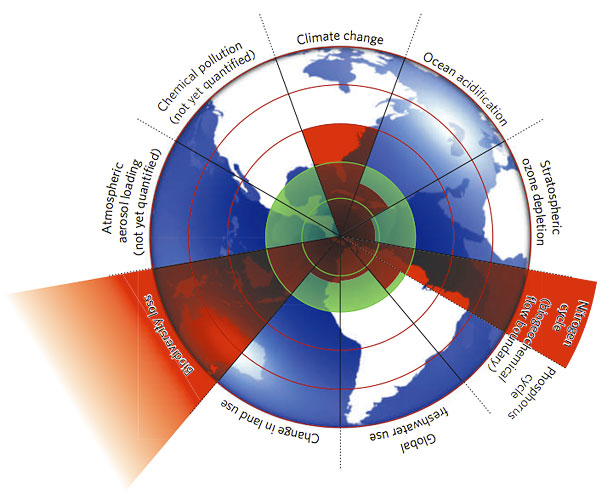
What you’re looking at there is an attempt to visualize the results (so far) of a workshop run last year in Stockholm that attempted to define the boundaries of a “safe operating space” in which the ecosystem of the planet can operate without veering towards catastrophe.
The 28 scientists worked out nine categories that they were comfortable setting some safe boundary conditions on, and then attempted to see where we were now with respect to those conditions. So far they’ve evaluated seven of their metrics, and we’re outside the safe zone on three of them–significantly so in some cases.
They aren’t saying the game is over–the boundaries mark points where we are in danger of irreversible “tipping point” type change, but they don’t necessarily indicate catastrophe:
“The idea is to say, ‘Let’s put up some guard rails,’” says Robert Costanza of the University of Vermont. “Maybe the guard rails are for a slope we could have taken and survived, but maybe not. We owe it to human civilization to be more careful.”
I’m generally in favour of any attempt to define the ways we can effect our ecosystem, and to understand the potential consequences of those–at this point we as a species are already capable of making too dramatic a change without understanding what we’re doing.
Now, ironically, civilization has become so powerful that it can reshape the planet itself. “We have become a force to contend with at the global level,” as Johan Rockstrom of the Stockholm Resilience Center in Sweden, puts it. Humans have changed the chemistry of Earth’s oceans, lowering their pH and causing ocean acidification. We are shifting the composition of the atmosphere, raising levels of carbon dioxide higher than they’ve been in at least the past 800,000 years.
Whether or not these limits are defined right, or are the most important ones, I’m not qualified to judge, but at a minimum they should not be ignored, and focusing some attention on them in the context of what kind of changes might move the ecosystem from an elastic change into plastic deformation seems pretty useful to me.
There’s lots more information about the workshop, and some counter-arguments, in the Yale Environment 360 article I pulled the picture and quotes from. There’s an even deeper level of information in the Nature.com special feature that the Yale article is based on–if you want the full story go there. In particular note that there are detailed commentaries on each of the boundaries available.
Looking at the visualization, I can’t help but wonder if Bostrom’s Great Filter–what I black-humouredly called the Doom Constant–isn’t possibly something ecological… Is it possible that civilizations that reach a certain technological point always (or at least a very high “usually”) manage to collapse their local ecosystem by unintended ecological side-effects of their “progress” before they expand beyond their local area of space? Or back to the zoo theory, is it possible that they just won’t talk to us until we learn to live somewhere without destroying it–I could kind of understand that, based on how I feel about student housing now that I’m a grown-up.
(Oh, and the post title, in case you didn’t catch the reference is a Walt Kelly nod.)


1 comment for “We have met the enemy”